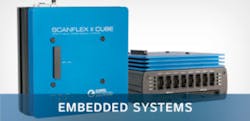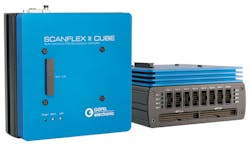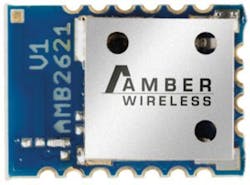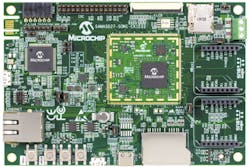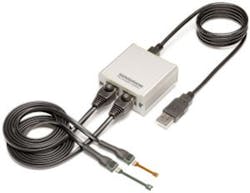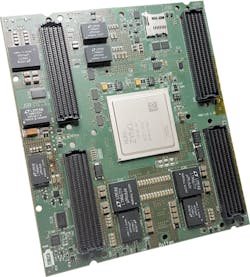Design through test technologies boost real-world intelligence
Embedded systems engineers face significant challenges in adding intelligence to myriad real-world applications. To succeed, they must select the proper tools to get their products to market quickly. They need software to assist in design, simulation, and code generation. They must choose the appropriate semiconductor devices or modules that provide the performance and efficiency they need, as well as passive components that minimize EMI. They need systems that can help them implement design-for-test strategies, that support debugging, and that can be leveraged for production test. In today’s connected world, they will likely have to implement wireless communications. And they will need instruments that can assist them throughout the design, test, and manufacturing process. EE-Evaluation Engineering asked several providers of software, semiconductors, DFT tools, and instruments to weigh in on their take on the embedded systems design and test process and describe how they help their customers succeed.
Design and simulation
According to Tom Erkkinen, manager, code generation and certification product marketing at MathWorks, “Our customers seek to design and verify highly sophisticated and complex algorithms and implement them into low-cost embedded devices which have minimal embedded resources. For example, some want to design millions of lines of code, or in Simulink-speak, thousands of blocks that automatically generate optimized code that fits inside a 16- or 32-bit processor and is easily verified.”
MathWorks serves customers working in aerospace, automotive, industrial-automation, audio, vision, robotics, medical, and autonomous-systems markets. “Customers using our products in these industries apply model-based design for many applications,” said Jay Abraham, manager, V&V product marketing, MathWorks. “Model-based design is built around the systematic use of models throughout the development process. It covers design, analysis, simulation, implementation, and verification. Automatic code generation is one of the technologies within model-based design where engineers see major time savings in their work, and improvements in quality.”
According to Erkkinen, key products include MATLAB, Simulink, Stateflow, Fixed-Point Designer, Embedded Coder, GPU Coder, HDL Coder, Simulink PLC Coder, Simulink Test, Simulink Coverage, Simulink Check, Simulink Design Verifier, Polyspace Bug Finder, and Polyspace Code Prover.
According to Mark Forbes, director of product and persona marketing for TASKING at Altium, “Most of our customers are in the automotive and agriculture markets. They are deep into engine and transmission controls and are now designing autonomous control systems. The market is rapidly growing as well. This leads to the two biggest challenges: getting designs done on time, but at the same time ensuring maximum safety of the product.”
Forbes described the company’s offerings for these customers. “TASKING (an Altium Brand) provides a complete toolchain for embedded software design for real-time, multicore, safety-critical applications such as automotive, transportation, and agriculture,” he said. “We have tools to cover Infineon TriCore/AURIX, RH850, and C166.” The company’s suite of products for TriCore/AURIX includes a C/C++ compiler and linker/locator as well as performance-optimization and safety tools. The performance tools include the TASKING Embedded Profiler and Embedded Debugger, TASKING LAPACK Performance Libraries, and the Bosch GTM Compiler. The safety tools include Safety Checker for ASIL Verification and a safety kit as part of the company’s ISO 26262 Support Program.
“Our products are designed specifically with safety in mind,” Forbes said. “Our compiler is optimized for the processor, allowing developers to exploit all the available features. We have tools to help find and fix underperforming code segments. And, we have tools to help ensure the design is safe and to help the customer acquire safety certification when the product is complete. TASKING is also ASPICE (automotive SPICE) Level 2-compliant, further easing safety certification for our customers.”
Test coverage
Thomas Wenzel, director of the embedded JTAG Solutions division at GOEPEL electronic, cited several challenges engineers are facing with their embedded designs. First, they face pressure to reduce the size of their electronics by using devices with the smallest footprint, which in turn leads to less and less physical access. They are also adding more analog sensors and actuators to their mixed-signal designs, leading to the need for mixed-signal test instruments. And they are designing deep embedded gigabit/second links, leading to the question of how to test them without tactile probing being possible.
In addition, Wenzel said, the complexity of hardware and software interaction leads to demands from system developers to verify hardware independent from native target software so they can identify hardware faults before unified system verification starts. And finally, using larger and larger onboard storage—in the 10- to 100-GB range—causes problems due to increasing programming time.
To address these challenges, GOEPEL offers a range of products for validation and prototype test of complex embedded electronics, beginning with tools to secure the testability of a product already in the design stage, followed by embedded solutions for the verification, test, debugging, and programming of a prototype in the lab. Finally, the company offers configurable system solutions using external instrumentation in architectures like PXI to enable full qualification of units.
Wenzel described GOEPEL’s product portfolio as horizontal, supporting market domains including automotive, consumer, medical, industrial, space and avionics, and transportation. “The challenges are quite comparable between these markets, but the degree of requirements and the respective ranking may vary,” he said. “The mission of our products is to enable testable designs based on embedded-access technologies to ensure high fault coverage, quick failure isolation and troubleshooting, and fast programming during the prototype phase.
Wenzel cited several recent developments. For example, the new SCANFLEX II platform supports embedded high-speed test and programming for mixed-signal designs with a total configurable platform solution (Figure 1). And extensions of the ChipVORX technology for control of FPGA embedded instruments cover Ethernet interfaces and test high-speed links via bit-error-rate test (BERT).
Courtesy of GOEPEL electronic
In addition, he said, extensions of the company’s VarioTAP technology for control of processors via debug interfaces support new models from Renesas, Cypress, Infineon, and others, enabling loading and controlled execution of customer IP as well as offering new features for NAND flash programming and RAM test.
The company has also added support for AES programming to improve the design security for FPGAs from Xilinx and Altera/Intel, and it offers a new hardware module to test DDR4 high-speed sockets and a new solution for embedded flash programming over an automotive bus to configure closed systems.
The semiconductor perspective
“The main challenge the designers are faced with is creating customized prototypes quickly and cost-effectively, while reusing their existing designs,” said Dirk Seidel, senior marketing manager at Lattice Semiconductor. “The widespread adoption of low-cost, mobile-influenced MIPI peripherals has created new connectivity challenges. Designers want to take advantage of the economies of scale that the latest generation of MIPI cameras and displays have to offer. But they also want to preserve their existing investment in legacy devices.”
Lattice offers a portfolio of smart connectivity products targeted for consumer, communications, industrial, and automotive applications. “For edge applications, small form factor, low power consumption (typically under 1 W), and cost are key differentiators,” Seidel said. “Lattice has production-proven FGPAs for a range of edge applications including smart home, smart city, smart car, and smart factory that meet these critical requirements. The company’s ‘mobile-influenced’ products can be integrated in edge-computing applications that deliver the same cost, power, and performance requirements.”
Seidel elaborated on one aspect of the company’s portfolio. “Lattice’s solutions such as our CrossLink FPGA target MIPI D-PHY bridging,” he said. “By providing programmable fabric, flexible high-speed I/Os, and hard-core MIPI D-PHY, CrossLink provides a small-form-factor, high-performance, flexible, and low-cost solution to address video-interface incompatibilities. For example, in 360 cameras, CrossLink can easily bridge and aggregate the content of two or more camera sensors to a single MIPI CSI-2 port. Similarly, CrossLink can also interface multiple camera sensors to perform mux/switch and merge to allow an applicator processor to choose which stereo cameras to connect and perform collision avoidance. Given the inherent programmable nature of FPGAs, embedded-system designers can preserve their original designs and achieve fast time-to-market for their next-generation products.”
From scopes to VNAs
Test instruments invaluable for embedded systems design and test include oscilloscopes, covered in our report on the topic. Several companies mentioned in that report have elaborated on embedded systems in general and the applicability of their scopes and other instruments in particular.
“Adding a digital ‘brain’ to a system can create some undesired after-effects including EMI, serial-bus cross-talk, and signal-integrity issues,” said Jason Chonko, applications marketing manager, Siglent Technologies America. “Fast digital rise times are especially problematic. Oscilloscopes, spectrum analyzers, and other general-purpose test equipment can help find the root causes of the issues and lead to cost-effective solutions.”
Chonko commented on one trend. “We have noticed electronics education programs integrating more digital-circuit, communications, and RF classes into their curricula,” he said. “This reflects the importance of these disciplines in the growing IoT and wearable markets. Our products give engineers visibility into their designs and the control to make them work exactly as intended.”
In addition to oscilloscopes, Chonko said Siglent manufactures a line of arbitrary waveform generators, including the new SDG6000X Series, that include an I/Q modulation option that can simulate serial-bus communications and add known-error conditions, like noise, to input signals. The company also offers power supplies, DMMs, and spectrum analyzers for general-purpose and RF applications. “For signal analysis, our free EasyScope software enables users to quickly collect data and screen images from the oscilloscope,” Chonko added. “This speeds troubleshooting and report generation for information sharing within a development group.”
“Embedded system designs are increasing in speed, sophistication, and connectivity (both wired and wireless),” said Trevor Smith, business development manager at Pico Technology. “At the same time, designers have to comply with ever more regulatory and compliance issues, including EMI/EMC, hazardous materials, packaging, and safety. So the challenges faced by embedded systems designers are plentiful—but their budgets are squeezed more than ever. Designers need multipurpose, affordable tools that help them to pinpoint errors and bugs in their designs early, and as fast as possible in the design verification stage of a project.”
Pico Technology recently introduced high-performance 25-GHz-bandwidth sampling scopes. “Those products address digital and telecommunications applications up to 10 Gb/s and precision timing applications with resolution down to 64 fs,” he said, adding that high-performance measurements of course require high-performance probes to make them. He said PicoConnect 900 Series microwave and gigabit test probes allow low-invasive fingertip browsing of broadband signals or data streams out to 9 GHz or 18 Gb/s.
Smith continued, “Embedded-system performance has increased a lot over the years, to the point that RF design considerations come into play for high-speed serial interfaces and communications channels.” To address those needs, the company has introduced the PicoVNA 106 vector network analyzer, a 6-GHz 2-port instrument with 118-dB dynamic range that is designed for characterization of high-frequency interfaces, devices, multipath interconnect, and antennas.
Another company offering VNAs suitable for embedded-systems applications is MegiQ. According to general manager Roger Denker, the company is targeting the booming IoT market with instruments including the USB-driven VNA-0460, a 6-GHz 2-port VNA with PC software, as well as the VNA-0460e, a 6-GHz 3-port VNA with built-in bias tee and bias voltage/current generator to allow parametric measurements. One goal, he said, is to help engineers “…get that nasty thing called an antenna to work.”
Copper Mountain Technologies also offers VNAs, and the company provides software options that facilitate embedded-system design, debug, and test, according to Brian Walker, senior RF engineer at the company. “One can control any of our measuring devices using SCPI over Windows COM or TCP networks,” he said. “We have also developed a number of custom wizards to automate test procedures for some of our customers.”
Walker continued, “Our customers are demanding faster measurement speeds and real-time triggering to accommodate high-speed, even belt-fed production test. With our focus on pure measurement instruments without slow and cumbersome embedded computers, Copper Mountain Technologies is particularly able to address these demanding requirements. Additionally, portable USB-powered measurement systems allow for the deployment of equipment outside the traditional test lab.”
Indeed, with regard to this last point, portable instruments are not just used for testing embedded systems—they become embedded in systems as well. Walker said that CMT’s handheld 1-port reflectometers such as the CMT R180 have been used to measure human tissue in medical applications, compaction of asphalt in road construction, paint thickness on an aircraft radome, protective-coating thickness on the interior of a natural-gas pipe, and moisture content of grain in an agricultural setting. “The possibilities are endless and limited only by the ingenuity and imagination of our customers,” he said. Figure 2 shows the R180 in an antenna test application.
Courtesy of Copper Mountain Technologies
Shrinking time-to-market windows
“At a high-level, the biggest problem is the lack of time in the day,” said Wilson Lee, technical marketing manager, Tektronix. “Embedded systems are getting more complex while time-to-market windows are shrinking. Engineers must make tough choices between budget and quality.”
He cited some challenges these engineers are facing. “For many embedded engineers, an important challenge is reducing human error when manually decoding bus protocols,” he said. “They want to reduce the time it takes to isolate a protocol error or correlate a system error to bus activity. In the automotive industry, for example, Tektronix has bus decoding and triggering packages that provide straightforward, automated decoding and triggering for popular ECU buses like CAN, CAN FD, LIN, and FlexRay.”
Lee continued, “Of course, protocol decoding is just the beginning. When a bus doesn’t work, or worse yet, works intermittently, then what should an engineer do?” The problem might relate to signal-integrity issues in the physical layer, like crosstalk, noise, and termination. Waveform analysis can help determine the source of the error. Lee said Tektronix offers oscilloscopes that provide the ability to actually look at the analog waveforms to evaluate signal quality and noise, scopes that can look at multiple signals for interactions and identify crosstalk, and IsoVu isolated measurement systems to see common-mode noise on signal lines.
Tektronix, he said, focuses on helping engineers get the insights they need in less time through features such as a comprehensive set of software applications plus an intuitive touch-based user interface on the 5 Series MSO. “Today’s engineers need answers and they need them fast, with as little friction as possible,” he emphasized.
Lee also commented on several 5 Series options. “The new 5-PWR power measurement and analysis solution enables designers to take advantage of the 5 Series MSO’s high channel count and 12-bit resolution to perform a range of automated power measurements and analysis including power quality, harmonics, switching loss, safe operating area (SOA), and a variety of additional measurements,” he said. “Designers working with the latest GaN and SiC power semiconductors will be able to combine the 5 Series MSO, 5-PWR measurement solution, and optically isolated IsoVu probes to enable multichannel, automated measurements of critical drive signals and switching voltages.”
He also commented on aerospace and automotive options. “The 5-SRAERO option offers serial trigger and decode solutions for the most common serial buses used in the aerospace industry including MIL-STD-1553 and ARINC 429.” In addition, “The upgraded 5-SRAUTO package offers complete serial triggering and analysis of the major buses used in the automotive industry, while the new 5-CMAUTOEN Automotive Ethernet solution provides automated compliance support for the IEEE P802.3bw (100BASE-T1) and BroadR-Reach V3.2 specifications.
Another key challenge is EMI/EMC precompliance testing. “Some 50% of designs fail EMC compliance testing in the first pass, leading to cost overruns and costly delays,” Lee said. Tektronix offers an all-in-one EMC pre-compliance test solution called EMCVu for its family of USB-based spectrum analyzers. “This solution is designed to help embedded engineers identify and correct EMC problems early in the design cycle, saving time and reducing risk,” he said.
Richard Patterson, product manager, oscilloscopes and ScopeCorders, Yokogawa, said his embedded-system-design customers face challenges related to high channel counts, highly mixed signals, and long recording times. The ScopeCorders’ long recording times, together with enhanced triggers and history functions, trap transient or intermittent problem behaviors, making it easier to root-cause issues and propose solutions.
“Embedded systems designers could benefit from our ScopeCorder Series of modular instruments, with modules for combining digital, analog, and sensor data,” he said. “As systems increasingly transform into ‘smart’ systems, the ability to combine all of these into one and observe complex behavior becomes more critical.” Citing automotive applications as an example, he said, “Combining digital vehicle bus data with other signals gives engineers a simultaneous view of the mechanical and the computing side of their systems.”
Speaking of software options, he said, “Our software Xviewer easily imports and displays data acquired from our oscilloscopes and ScopeCorders. It can remotely control these instruments and replicates many of the features of the scopes and ScopeCorders on a PC display for post-processing and inspection. It can also convert into popular file formats such as CSV.”
In addition, he said, “Our Symbol Editor software is for creating and editing physical-value symbol-definition files for serial-bus analysis. For example, a CANdb file can be imported and used for easy decoding on our oscilloscopes.”
The company also offers power-analysis instruments, which he said are valuable for renewable-energy, inverter, and electric-vehicle applications. “Options for power analysis automate popular measurements in real-time such as power factor and harmonics,” Patterson said. “This eliminates the need for post-processing, in turn speeding up design and troubleshooting tasks.”
News from embedded world 2018
As this article was going to press, embedded world 2018 was concluding in Nuremberg. The event offered other companies an opportunity to highlight their products and technologies. For example, Zuken and XJTAG at the show released a plugin that will enhance Zuken’s CR-8000 PCB design software with a design-for-test (DFT) capability, improving test coverage by allowing additional design checks during schematic entry. The capability is based on XJTAG’s DFT Assistant.
NI at embedded world announced new CompactRIO controllers that include NI-DAQmx and Time Sensitive Networking (TSN). These controllers offer deterministic communication and synchronized measurements across standard Ethernet networks to increase performance and help improve productivity in addition to flexibility. NI said it was the first to market with industrial embedded hardware supporting TSN, the next evolution of the IEEE 802.11 Ethernet standard, and the company provides these controllers as part of its continued investment in TSN. Engineers can use TSN to synchronize distributed systems across networks, which eliminates the need for costly synchronization cables.
ON Semiconductor released a new multisensor shield and announced an expansion of software support for its IoT Development Kit (IDK). With the new release, the company said, customers can accelerate development timeframes and deploy IoT solutions quickly for a variety of connected wellness and industrial wearables as well as for smart-home, predictive-maintenance, asset-tracking, and other industrial IoT applications.
Luxoft exhibited its suite of automotive technology services, highlighting its AUTOSAR adaptive demonstrator, LuxTrace trace management for timing testing, LUI Augmented Reality AR user interface platform, Triton UI automotive reference UI for the Qt automotive suite, AllView II HMI demonstrator, and Populus UI design, development, and deployment tool. The company also demonstrated an automotive reference platform codeveloped with Intel.
Presto Engineering at embedded world discussed its test and manufacturing services, with a particular emphasis on solutions for IoT chip security. Turning a design into a chip requires a highly secure manufacturing supply chain, the company said, adding that it can manage the entire chip manufacturing and testing process to make chips with levels of security up to that needed for banking standards, including the secure provisioning of cryptographic keys.
Rohde & Schwarz Cybersecurity at embedded world highlighted enhancements to its R&S PACE 2 deep packet inspection (DPI) software to include Stratum protocol classification capabilities. The company said the DPI engine can now reliably classify and therefore enable network security solutions to block malicious mining activities.
Würth Elektronik eiSos said a key topic for the company at the exhibition was suppression, and it described high-frequency optimized multilayer ferrites for use on signal lines. The company also highlighted aluminum electrolyte capacitors, including the WCAP-PSHP aluminum-polymer capacitor. Its subsidiary AMBER wireless showcased the AMB2621, an ultralow-power 2.4-GHz wireless module (Figure 3), as well as the AMB8826 868-MHz long-range wireless module and the AMB2220 2.4-GHz long-range wireless module. And the IQD Frequency Products subsidiary presented its portfolio of quartz and oscillator products.
Courtesy of Würth Elektronik eiSos
Microchip Technology at embedded world introduced the MPLAB PICkit 4 in-circuit debugger, which replaces the PICkit 3 programmer by offering five times faster programming, a wider voltage range (1.2 to 5 V), improved USB connectivity, and more debugging interface options. In addition to supporting Microchip’s PIC microcontrollers (MCUs) and dsPIC digital signal controllers (DSCs), the tool also supports debugging and programming for the CEC1702 family of hardware cryptography-enabled devices. And in the runup to the event, Microchip unveiled a new system on module (SOM) featuring the Arm Cortex-A5-based SAMA5D2 MPU. Designated the ATSAMA5D27-SOM1 (Figure 4), the new SOM contains the recently released ATSAMA5D27C-D1G-CU system in package (SiP), and it simplifies design by integrating the power management, nonvolatile boot memory, Ethernet PHY, and high-speed DDR2 memory onto a small, single-sided PCB.
Courtesy of Microchip Technology
Some other embedded world exhibitors had not reported their plans for the event but have recently announced new products. For example, embedded world exhibitor SEGGER announced that a certified version of its embOS RTOS is now available for safety-critical applications. Certified by TÜV SÜD, embOS-Safe complies with the functional safety standards IEC 61508 SIL 3 and IEC 62304 Class C (medical devices). The company said the certification makes it easier to use embOS in key safety-critical medical, automotive, aviation, and home-appliance market segments.
Courtesy of Sensirion
Also an embedded world exhibitor, Sensirion recently introduced its next evaluation kit, called SEK-Environmental Sensing (Figure 5), which allows engineers to evaluate sensors and develop innovative sensor applications quickly and easily. The kit combines plug-and-play hardware with an easy-to-use viewer software, the ControlCenter, enabling in-depth evaluation of all Sensirion environmental sensors. Each evaluation kit includes a Sensirion SensorBridge, all required connector cables, and various sensor samples.
And finally, PRO DESIGN Electronic GmbH chose another concurrently running event—DVCon in San Jose—to highlight three new proFPGA Zynq UltraScale+ FPGA modules (Figure 6), which offer an embedded-processing platform for the efficient development and verification of SoC and IP designs, the company said, describing the proFPGA product family as a complete, scalable, and modular multi-FPGA prototyping solution. The new members are the proFPGA Zynq UltraScale+ ZU11EG, ZU17EG, and ZU19EG FPGA modules, which can be mounted on the proFPGA uno, duo, or quad motherboards and mixed with other proFPGA FPGA modules like Virtex-7, Virtex UltraScale, Virtex UltraScale+, or Kintex UltraScale modules. The proFPGA Zynq UltraScale+ FPGA modules address customers who require a complete embedded processing platform for high-performance SoC prototyping, IP verification, and early software development.
Courtesy of PRO DESIGN Electronic GmbH
For more information:
- Altium
- Altium
- Copper Mountain Technologies
- GOEPEL electronic
- Lattice Semiconductor
- Luxoft
- MathWorks
- MegiQ
- Microchip Technology
- National Instruments
- Pico Technology
- Presto Engineering
- PRO DESIGN Electronic GmbH
- Rohde & Schwarz
- SEGGER
- Sensirion
- Siglent Technologies
- Tektronix
- Würth Elektronik eiSos
- XJTAG
- Yokogawa
- Zuken
About the Author

Rick Nelson
Contributing Editor
Rick is currently Contributing Technical Editor. He was Executive Editor for EE in 2011-2018. Previously he served on several publications, including EDN and Vision Systems Design, and has received awards for signed editorials from the American Society of Business Publication Editors. He began as a design engineer at General Electric and Litton Industries and earned a BSEE degree from Penn State.
